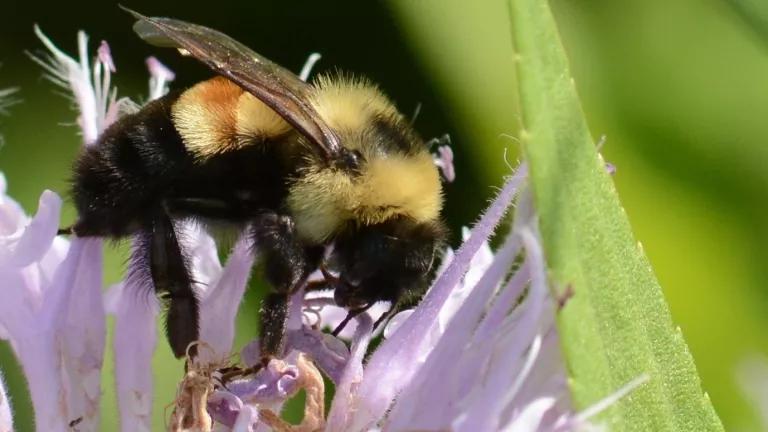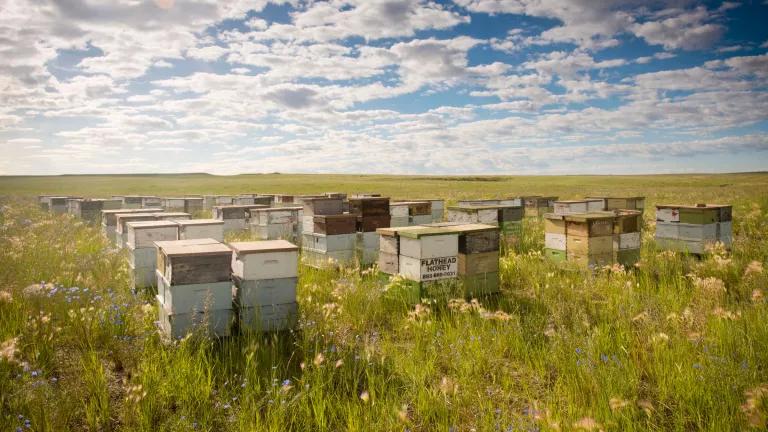The Rusty Patched Bumble Bee Needs Another Legal Win
NRDC is headed to court again to protect critical habitat for the endangered rusty patched bumble bee. The bee, other pollinators, and the future of our food supply depend on it.

A rusty patched bumble bee forages at a flower.
NRDC and partners head to court for a fourth time to secure needed habitat protections for the endangered rusty patched bumble bee.
NRDC, the Center for Biological Diversity, and Friends of Minnesota Scientific and Natural Areas filed a lawsuit to challenge the refusal of the U.S. Fish & Wildlife Service (the Service) to designate “critical habitat” for the rusty patched bumble bee. The Service’s decision leaves the bee’s habitat without foundational protections under the Endangered Species Act (ESA) and could spell doom for a species already nearing the brink of extinction.
Wild bees, like the rusty patched, serve an indispensable role as pollinators, upholding the planet’s ecosystems and agricultural systems. Their value far exceeds the benefits they provide to humans, and yet they are responsible for pollinating so many of the crops we eat to maintain healthy diets, including apples, blueberries, and cherries.
Although the bee is the first and only bee in the continental United States to be recognized as endangered under the ESA, its disappearance from a staggering 87% of its native range is just one example in a broader trend of native bee population decline. In a country where many low-income communities and communities of color already face food insecurity and lack access to healthy foods, it is all the more important that we halt and reverse these pollinator losses.

Many fruits and vegetables, including berries, benefit greatly from pollination by bees.
To reverse course for the rusty patched bumble bee, the Service needs to apply the ESA to the fullest extent possible. The law says the Service must designate critical habitat—areas that are essential to the survival or recovery of species—unless doing so would not be “prudent.” When enacting the ESA, Congress intended this exception to be rare, reserved for circumstances in which designation will not benefit the species.

Rusty patched bumble bees need a diversity of flowering plants to sustain themselves throughout their long active season.
The Service’s decision to leave the rusty patched bumble bee without critical habitat, however, unlawfully expands this exemption. It also contradicts evidence that habitat loss and degradation have contributed to the bee’s decline, and that habitat protection is an important factor in its survival and recovery. In fact, designation would help the bee in a number of ways, including:
- Protecting high-quality habitat outside the bee’s current range—The bee occupies a tiny fraction of its native habitat, and remaining populations are frequently isolated. Designating high-quality habitat around those occupied areas could help the bee to expand its range and ensure connectivity between populations, preserving genetic diversity and increasing resilience to habitat modification, pesticides, disease, and climate change.
- Providing havens from widespread pesticide application—Pesticides like neonicotinoids and glyphosate are major threats to the bee and its habitat. By designating areas of federal land, the Service could ensure that the bee’s habitat needs guide management decisions and limit use of these pesticides in areas where the bee might find a home.
The benefits of protecting habitat are especially apparent in light of historical destruction of grasslands the bee had called home. The rusty patched bumble bee was once common in flower-rich grassland and tall-grass prairies throughout the midwestern and northeastern United States, but 99.9% of the United States’ grassland has disappeared since the settlement of the continent by Europeans. The Service must play a central role in protecting the habitat that remains, which is why NRDC is taking its fourth legal action to provide the rusty patched bumble bee with the legal protection it needs—and that which the ESA requires.
We’re confident that this lawsuit will result in critical habitat protections that not only benefit the bee, but safeguard the future of our food system and protect the grasslands and woodlands that countless species call home. Check back for updates as the case progresses.



